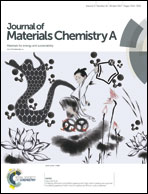Metal–organic frameworks in seconds via selective microwave heating†
Abstract
Synthesis of metal–organic framework (MOF) materials via microwave heating often involves shorter reaction times and offers enhanced control of particle size compared to conventional heating. However, there is little understanding of the interactions between electromagnetic waves and MOFs, their reactants, and intermediates, all of which are required for successful scale-up to enable production of commercially viable quantities of material. By examining the effect of average absorbed power with a constant total absorbed energy to prepare MIL-53(Al) we have defined a selective heating mechanism that affords control over MOF particle size range and morphology by altering the microwave power. This is the first time a selective mechanism has been established for the preparation of MOFs via microwave heating. This approach has been applied to the very rapid preparation of MIL-53(Al)ta (62 mg in 4.3 seconds) which represents the fastest reported synthesis of a MOF on this scale to date.

- This article is part of the themed collection: 2017 Journal of Materials Chemistry A HOT Papers


 Please wait while we load your content...
Please wait while we load your content...